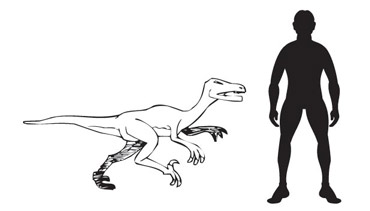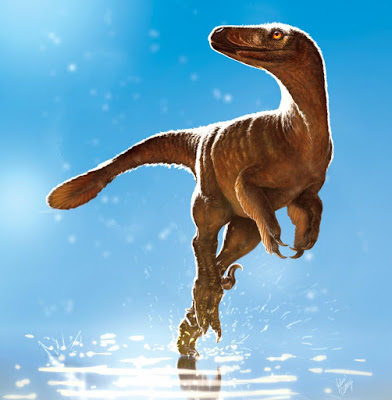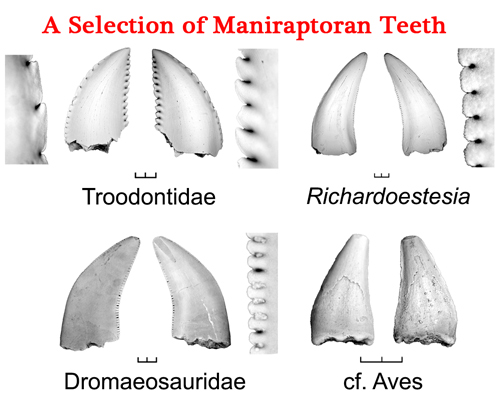Troodon formosus – No Longer Valid
One of the first ever dinosaurs named from North America has officially bitten the dust in taxonomic terms as the troodontid Troodon formosus is no longer a valid genus.
This fast-running, bird-like dinosaur was first named and described in 1856 by the American palaeontologist Joseph Leidy and right from the very beginning there were problems over its description and classification. Troodon (T. formosus), a dinosaur whose name provided the inspiration behind the erection of an entire dinosaur family, the Troodontidae (part of the Deinonychosauria clade), was described on the basis of the discovery of a fossilised tooth.
Troodon formosus = Nomen Dubium
The teeth of these types of dinosaurs are recurved and have large serrations, unlike any dinosaur teeth found previously and so Leidy erected a new genus – Troodon (the name means “wounding tooth”). This staple of dinosaur books and academic literature for the best part of 160 years had been established on fairly shaky ground to begin with. Now thanks to some new research from University of Alberta graduate student Aaron van der Reest, T. formosus has been replaced by two taxa, one new one Latenivenatrix mcmasterae and one resurrected one.
As a result of this new study, which has led to the reclassification of North American troodontid fossil material, the species Stenonychosaurus inequalis, first described by Sternberg in 1932 and previously regarded as a junior synonym of Troodon has come back into favour.
An Illustration of the Bird-like, Sickle-toe Clawed Troodon (T. formosus)

A scale drawing of a typical member of the Troodontidae dinosaur family. Picture credit: Everything Dinosaur.
Picture credit: Everything Dinosaur
Hips Brought Everything to a Head
In the early summer of 2014, van der Reest discovered an intact troodontid pelvis in Dinosaur Provincial Park Formation of southern Alberta. This led to him conducting an in-depth analysis of previously collected troodontid fossils, including skull bones. His research concluded that the Dinosaur Provincial Park fossil record held two genera of troodontid and not one.
For most of the 19th and 20th centuries troodontid fossils from North America tended to be assigned to T. formosus. Based on this, Troodon ranged from Mexico in the south to Montana and beyond Alberta in the north and existed as a species through some fifteen million years. A contradiction indeed, when the rapid dinosaur faunal turnover of Laramidia in the Late Cretaceous is considered.
The shape of the pelvic bones, particularly the pubis led to the erection of the new species – Latenivenatrix. It comes from the upper Dinosaur Park Formation (Late Campanian) and following the student’s reassessment of troodontid fossil material from strata representing the youngest layers of the Dinosaur Park Formation, other fossil elements including partial skulls have been assigned to this species. Latenivenatrix (the name means “hiding hunter”), a reference to the muddle and confusion surrounding North American troodontids, was a relative giant amongst its kind.
Aaron van der Reest explained:
“This new species is the largest of the troodontids ever found anywhere in the world, standing nearly two metres at the head and close to 3.5 metres long. It’s about fifty per cent larger than any other troodontids previously known, making it one of the largest Deinonychosaurs (raptor-like dinosaurs) we currently recognise.”
An Illustration of the Late Cretaceous Troodontid Latenivenatrix mcmasterae
Picture credit: Julius Csotonyi
Student van der Reest added:
“The hips we found could ultimately open the door for dozens of new species to be discovered. Researchers with other specimens now have two new species [Latenivenatrix mcmasterae and Stenonychosaurus inequalis] for comparison, widening our ability to understand the troodontid family tree in North America.”
Confusion Amongst North American Troodontids
Troodontids are known from both Asia and North America, the most complete specimens come from Upper Jurassic Strata of China, Lower Cretaceous strata of China (western Liaoning Province) and the Cretaceous of Mongolia. In contrast, troodontids from the western hemisphere, specifically Mexico, USA and Canada are very poorly known with a very fragmentary fossil record. Previously unassigned fossils from the lower part of the Dinosaur Park Formation have now been assigned to the resurrected troodontid species Stenonychosaurus inequalis.
A Comparison of Maniraptoran Teeth
Honouring Mum
For Aaron, being able to name a new dinosaur has been an especially emotional experience. The species name for Latenivenatrix mcmasterae honours his late mother, Lynne (McMaster) van der Reest who did so much to encourage him to pursue a career in palaeontology.
Thanks to this new study, the story of troodontids in North America is a little clearer. A distinct stratigraphic separation between Stenonychosaurus inequalis and the younger troodontid Latenivenatrix mcmasterae has been established. A phylogenetic analysis indicates that Latenivenatrix is more closely related to Asian Troodonts than it is to Stenonychosaurus, this suggests that the replacement of Stenonychosaurus may have resulted from an earlier Asian migrant into North America.
For the time being Troodon formosus is no more.
The scientific paper: “Troodontids (Theropoda) from the Dinosaur Park Formation, Alberta, with a Description of a Unique New Taxon: Implications for Deinonychosaur Diversity in North America” by Aaron J. van der Reest and Philip J. Currie published in the Canadian Journal of Earth Sciences.
Visit the Everything Dinosaur website: Everything Dinosaur.








[…] this new species, those four fossil specimens were tooth specimens. And as we have all learned from our friend Troodon, you cannot describe a species from ordinary tooth remains. So, that was the end of Szechuanosaurus […]